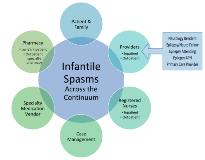Infantile Spasms: Improving Care Across the Continuum
Abstract number :
3.419
Submission category :
13. Health Services (Delivery of Care, Access to Care, Health Care Models)
Year :
2018
Submission ID :
501821
Source :
www.aesnet.org
Presentation date :
12/3/2018 1:55:12 PM
Published date :
Nov 5, 2018, 18:00 PM
Authors :
Lauren Cochran, Lurie Children's Hospital of Chicago and Eileen Romano, Lurie Children's Hospital of Chicago
Rationale: The care of patients with infantile spasms (IS) is complex and spans the continuum of care. At Ann & Robert H. Lurie Children's Hospital of Chicago we treat up to 3-4 patients per month that are newly diagnosed with infantile spasms. Diagnosis and treatment are initiated during an inpatient admission and are continued in the outpatient setting. When inpatient and outpatient providers do not collaborate, challenges arise in the care of patients diagnosed with IS. The aim of this project is to improve coordination across the continuum of care and therefore improve the quality of care for patients with IS. Methods: An analysis was performed to identify the current processes, areas for improvement and gaps in continuity of care of patients treated for IS at Lurie Children's. In this process, the authors met with all constituents of the healthcare system. This evaluation revealed many areas of challenge and indicated the need for better coordination of care across the continuum. Therefore, multiple interventions were implemented to address areas of challenge. First, outpatient nurses identified a high volume of medication management issues related to ACTH and the need to coordinate inpatient and outpatient nursing efforts. Following the evidence based practice method, a literature review was performed regarding injection technique which led to updated recommendations to practice. These recommendations were implemented into practice as a new standard across inpatient and outpatient nursing. Then nursing representatives from both settings collaborated to create updated education materials for parents and nurses. Other areas for collaboration were identified as lines of communication were opened and relationships were built amongst the other members of the multidisciplinary health care team. For example, meetings with the specialty medication pharmaceutical companies improved patient access to medications. In addition, a clinical pathway and Epic order set are being created to standardize and streamline the inpatient and outpatient care of patients with infantile spasms. Also being updated are the individualized plan of care (IPOC) and teaching protocol for patients admitted for infantile spasms. Results: A retrospective chart review was completed to audit quality improvement interventions. The sample of 28 patients was separated into two cohorts: fiscal year 2017 and fiscal year 2018. The chart review demonstrated a decrease in reported ACTH medication management issues and ACTH injection issues when comparing fiscal year 2017 actual data vs. fiscal year 2018 annualized data. Other reported results include improved teamwork and communication across the continuum of care and decreased parent anxiety and stress, with more parents reporting confidence in medication management and administration. Conclusions: The implemented interventions improved coordination across the continuum of care and improved patient care outcomes in two specific measurements regarding ACTH medication management and administration. Continued work needs to be done to address continued areas of challenge, to strengthen coordination across the continuum of care and measure a broader spectrum of patient outcomes. Funding: None

.tmb-.png?Culture=en&sfvrsn=1254a6b2_0)